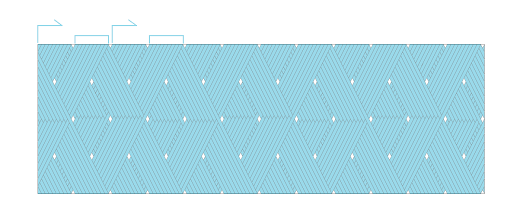It has been quite a long time since my last post and it's October now. I meant to post this sooner, actually I have started this post at the beginning of July but I have been a bit busy..... well, no excuse. Here is another variation of of bi-coloured scales design.
This is a very simple design with a single colour for both stitching paths and a contrasting colour at the mid-point and last of the section. However, if you stich as if it's a good old bi-coloured scales design and switch the colour of the thread at the mid-point and switch back to the original one and continue stitching until the section is filled with stiches except for the last row of the stitch for which you switch to the contrasting colour again, your thimble appears like below:
The difference of the designs between top photo and the above design diagram comes from the way the threads layer each other. When you make a new row of stitches, the thread travels on the thimble body and it layers on the existing thread(s) and form the design. And so, the contrasting colour at the mid-point does not appear fully as the design of the thimble does in the photo because the latter half of the threads in the original colour lay on the thread of the contrasting colour.
Now I am going to explain how to stitch the thimble in the photo. Start stitching as usual and stop one stitch before you got to the mid-point and finish the thread. You have to know how many stitches you make in one section so that you will know when to stop stitching for this design:
= "total number of the stitches in one section" / 2 - "1 stitch"
In the diagram above, it requires total 20 stitches to fill one section so I made nine stitches. 20 devided by 2 and minus 1 makes 9.
= "total number of the stitches in one section" / 2 - "1 stitch"
In the diagram above, it requires total 20 stitches to fill one section so I made nine stitches. 20 devided by 2 and minus 1 makes 9.
Start a new thread leaving a space for just one stich.
Continue stitching until all are filled with stitches but a tiny space for the last stich. You are going to make the same number of the stitches for the second half of the section and it automatically give you a space for one stitch. In the diagram above, I made another nine stitches. There are four spaces left in two sections (two stitching paths), 2 at the mid-point and another two at the last.
Start a new thread in the contrasting colour and start stitching for all four spaces and you will get your new thimble now. You can compare the above diagram with the top one and see in the top diagram the latter half of the blue threads covers the half of the first yellow thread and it makes a big difference on the finished thimble.
Some of you may wonder if you could make the same design by having four stitching paths in the same colour with a contrasting colour for the last stich, instead. The answer is YES. Well, sort of, not totally the same but quite similar.
See? It looks quite similar, but not THE same. However, it does not much of a difference. The effect is (almost) the same.
This is not bi- but quad-coloured scales though all four sections are in the identical colour scheme. In this way you stich four stitching paths in the same colour and switch the colour just for the last stitch. It's certainly more easier than stich the design as bi-coloured scales.
This is not bi- but quad-coloured scales though all four sections are in the identical colour scheme. In this way you stich four stitching paths in the same colour and switch the colour just for the last stitch. It's certainly more easier than stich the design as bi-coloured scales.
However, stitching as bi-coloured scales and quad-coloured scales have a big difference. Firstly you only have two working threads at one time for bi-coloured, while four for quad-coloured. Having four is not a big deal, but how about eight, or perhaps sixteen?
The above diagram is a quad-coloured scales with the technique of stitching the mid- and last stitches lastly. You can of course stitch this as oct-coloured, I mean, 8 section design period. The design period is the number of the sections where the thread travels from the top to bottom and then up to the top again. In this design the tread travels total eight sections, that is, 8 section design period. I believe I have posted about the design period and design repeat in the past. Having eight working threads is not very easy to handle especially all are in the same colour because you have to make track of which stitching path you are working with all the time, and more importantly, what you are making is a ring sized object. Working on the ring sized object with eight threads hanging is NOT easy at all,I can tell you.-------
Lastly, I would like to thank you all who bought my "First Thimble Kit" via Etsy. If you are interested in the kit, there is a link to my Etsy shop on the right column. I am sorry but at the moment I cannot ship it to EU countries through Etsy due to their new duty declaration system. If any of you who lives in the EU countries and would like to buy the kit, please kindly contact me. My profile page has my email address.








